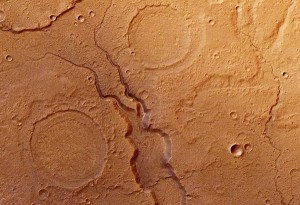 A lot of people think of Mars as a desert planet, racked by dust storms, covered in dunes, and dry as a bone. These things are all true but only just barely. Lately, scientists have been gazing at Mars from orbit and landing rovers on its surface that tell another tale, one implying a warmer and wetter world: a place of oceans, lakes, rivers and rain. So which is it then? Warm and wet or cold and dry?
A lot of people think of Mars as a desert planet, racked by dust storms, covered in dunes, and dry as a bone. These things are all true but only just barely. Lately, scientists have been gazing at Mars from orbit and landing rovers on its surface that tell another tale, one implying a warmer and wetter world: a place of oceans, lakes, rivers and rain. So which is it then? Warm and wet or cold and dry?
Any astronomer worth his or her salt (and there’s plenty of that up there too) would tell you Mars is cold and dry, and they’d be quite correct. There’s no current evidence of water anywhere on Mars’s surface, just ice, ice and more ice. Any water vapor in the thin air tends to come down as snowflakes, further dehydrating an already dry environment. Even the atmosphere of carbon dioxide tends to freeze and fall from the sky as dry ice snow. It’s a pretty dry place.
But the landscape seen from orbit tells another tale and tells it pretty clearly. The photo above, snapped by a European space probe, shows that in addition to the craters we expect to see on most astronomical bodies, there are some pretty obvious signs of water, like those river channels running toward the bottom of the picture. Such channels are common on Mars, but they’re always dry. On Earth, we’d just assume that you need to wait for the next rainy season and they’d be filled with water, which we’d expect to see flowing down to lakes or oceans. In this case though, the empty channels flow into or out of craters, not ponds.
Or are they ponds after all?
 What is it that fills those flat-bottomed crater holes? Most scientists suggest lava, but I think maybe not. I’d say it seems just as likely that the craters are filled with the stuff water always washes along with it when it flows along channels and canyons: sand and mud. What if, back in warmer and wetter times, those craters’ deep bottoms were filled by megatons of water-deposited sand and mud, carried there bit by bit, century after century, by rivers and streams, until those craters took on that flat and mostly featureless look they sport today? Is that so impossible? I don’t think so, and I’m a bit of an expert, living in Seattle as I do, where mudflats are a common land feature.
What is it that fills those flat-bottomed crater holes? Most scientists suggest lava, but I think maybe not. I’d say it seems just as likely that the craters are filled with the stuff water always washes along with it when it flows along channels and canyons: sand and mud. What if, back in warmer and wetter times, those craters’ deep bottoms were filled by megatons of water-deposited sand and mud, carried there bit by bit, century after century, by rivers and streams, until those craters took on that flat and mostly featureless look they sport today? Is that so impossible? I don’t think so, and I’m a bit of an expert, living in Seattle as I do, where mudflats are a common land feature.
On earth, mud and sand tend to harden and turn to rock over time, forming mudstone or sandstone. Alternatively mud, sand, and water can freeze to make permafrost, which takes on the properties of solid ground at ultra-cold temperatures like those found at Earth’s poles or everywhere on Mars.
So the landscape of Mars may be a desert in only the most superficial of ways, just on the surface and not at any depth beyond a few inches. In fact, the Phoenix lander’s retro rockets actually blasted the dusty covering off of a layer of white stuff the scientists decided, after more testing and talk than probably was necessary, was essentially pure WATER!
I’m going to jump ahead of the rocket scientists here and place a bet. I’ll bet MOST of Mars is covered by one form or another of ice, frozen mud, permafrost, or other forms of wetness that haven’t even been imagined yet. I’ll go a step farther and suggest that if you warmed the planet up a bit, you’d get one huge mudball — a real mean mess of muck. Mudball Mars.
Now it may seem I’m belaboring a point, but here’s the concept: future explorers of Mars may not be troubled by dust so much as by mud. As Kim Stanley Robison wrote in his Red Mars, Green Mars, Blue Mars series of novels describing the terraforming of Mars to make it habitable for people, there may come a time when water flows on the surface of Mars as it did in the distant past. But Robinson’s stories glossed over the issue of mud too easily, I think. When humans do someday change the Red Planet, be they so inclined, then I believe their greatest challenge will be figuring out how to deal with all the mud they’ve unleashed when they warm the place up.
I think soon I’ll write a science fiction story that takes a look at the challenges of life on Mudball Mars. Here’s a sample line of dialog:
“Eeew! Look at all the muck you’ve tracked into the habitation module! Now, who’s going to clean that up?”







